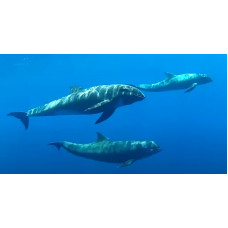Latin name
Peponocephala electra
Other names
Electra dolphin, little killer whale, many-toothed blackfish.
Identification
It has a streamlined, torpedo-shaped body. Its head is a rounded cone, giving the animal its name. Compared to females, adult males have more rounded heads, longer fins, higher dorsal fins, wider caudal fins, and some have a pronounced ventral keel on the back of the hindwing.
Features of fish fins
The dorsal fin is high with a pointed tip, similar to that of an orca. It is crescent-shaped and located approximately in the middle of the back.
Fish colouring
The body coloration is more or less uniformly light gray, except for a dark gray muzzle, sometimes called a "mask.
Distribution
Hawaii, the Maldives, the Philippines and the eastern Caribbean, especially around Dominica, are the best places to see these dolphins.
Habitat
They inhabit deep tropical/subtropical oceanic waters between 40°N and 35°S. They are considered a coastal pelagic species, but in some regions (e.g. Hawaii) there are populations that can be found close to shore. Melon-headed whales are not known to migrate.
Size
An adult dolphin grows up to 3 meters long and weighs over 200 kilograms. A newborn dolphin weighs 10-15 kilograms and is about 1 meter long. Life expectancy is at least 20 years for males and probably more than 30 years for females.
Behavior
This dolphin is capable of swimming very fast, especially when frightened. While swimming, it often makes short, low jumps away from the surface, creating large splashes of water. Dolphins usually congregate in large groups (at least 100 heads, occasionally probably over 1000).
According to observations of dolphins off Hawaii, these animals spend most of their day on the surface resting.
Food and feeding habits
They feed primarily on pelagic and mesopelagic squid and small fish. They feed at night when their prey is 400 m (1,300 ft) above the surface.
Reproduction
They reach sexual maturity at 13-15 years of age and live to be 45 years old.
Fishing
Melon-headed whales are occasionally caught as by-catch in tuna fisheries in the eastern tropical Pacific.
Relationship with a person
Animals caught as bycatch are sometimes used as bait in fisheries.
| Classification | |
| Phylum | Chordata |
| Class | Mammalia |
| Squad | Artiodactyla |
| Family | Delphinidae |
| Genus | Peponocephala |
| Species | P. electra |
| Features | |
| Conservation status | Least Concern |
| Habitat | Pelagic |
| Life span, years | 45 |
| Maximum body weight, kg | 200 |
| Maximum length, cm | 300 |
| Sailing speed, m/s | No information |
| Threat to people | Edible |
| Way of eating | Predator |
Melon-headed whale
Tags: melon headed whale


